Stop and Search code of practice: twelve month review - quantitative report
Findings of a quantitative study which evaluates change in the use of police searches and alcohol seizures in the twelve months before and after the introduction of the Code of Practice.
6. Searches and seizures for people with protected characteristics
6.1 Introduction
In recent years, a series of reports (Murray 2014, 2015; Murray and McVie 2016; McVie and Murray 2017) have highlighted a high degree of disproportionality in the use of stop and search amongst children and young people in Scotland. These reports also found that rates of stop and search were higher amongst men than women, and there were some ethnic disparities (although the lack of accurate population data on minority ethnic groups means that no definitive conclusions can be drawn about ethnic bias in the use of searches). During the public consultation on stop and search, there was significant concern about the approach to searching children and young people and how this might impact on their attitudes to, and cooperation with, the police. As a result, Section 7 of the CoP specifically addressed the issue of searches involving children and young people, and Police Scotland provided training for all officers aimed at improving methods of engagement with young people. The training also examined the issue of unconscious bias when dealing with any individuals with other protected characteristics.
This section of the report examines any change in the profile of searches in the twelve months following the introduction of the CoP and whether rates of search appear to be disproportionately higher and detection rates disproportionately lower in respect of any group with protected characteristics, but most especially children and young people. One limitation of the data presented in this section of the report should be noted. It is known that some people are subject to multiple searches; however, the data provided by Police Scotland did not provide an indicator of multiple searches. Therefore, some individuals will be counted more than once in the analysis presented in this section. Provided numbers of people who are searched on multiple occasions are small, this should have a relatively small effect on the analysis presented here. However, it is highly possible that there is a bias in terms of the types of people likely to experience multiple searches and that this is based, in part, on their protected characteristics. This means that some of the differences between groups presented in this section may appear larger than they actually are (this is discussed specifically in relation to the analysis by ethnic group).
6.2 Change in search and seizure rates by age, sex and ethnicity
6.2.1 Age
Rates per capita were calculated using the number of searches and seizures across different age groups in order to determine differences in the extent to which these tactics are applied taking account of population size. Figure 6.1 compares the rate of search per 10,000 people for different age groups in the twelve months before and after the CoP was introduced. During both time points, those aged between 16 and 19 were most likely within the population to be searched. In the year after the CoP was introduced, the rate of search fell for all age groups, with the largest reduction being in the youngest age groups. The search rate fell by 31% for those aged under 16 and by 36% for 16-17 year olds, compared to a 15-22% fall across all other age groups. The extent of the decline in searches amongst 16-17 year olds was such that it was surpassed by the 18-19 year olds as the most searched age group. So, while there was still a disproportionate use of search amongst younger people after the introduction of the CoP, the evidence suggests that the extent of this had reduced significantly.
Figure 6.1: Search rate per capita by age group pre- and post-implementation of the CoP
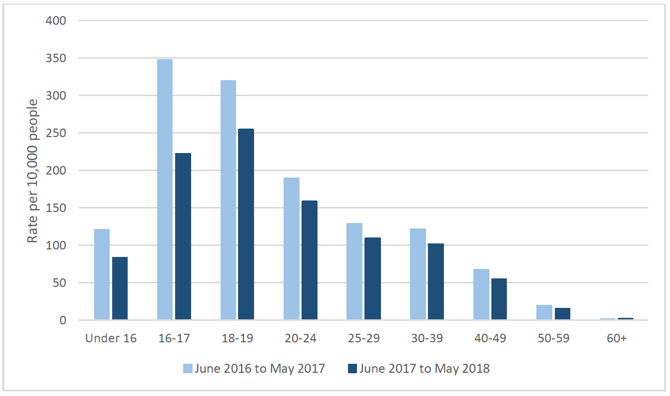
Figure 6.2 compares the seizure rates by age group pre- and post-implementation of the CoP. Rates of seizure were much lower than search rates overall, and they declined to a much greater extent after the introduction of the CoP (as noted in Section 2). Unlike the search rates, however, the decline in the rate of seizures was proportionately much greater for people in the older age groups than it was for younger people (as discussed in relation to alcohol seizures in section 3.3). Seizure rates fell by 38% for young people under 16 and by 53% for those aged 16-17. This compared with a decline in seizure rates of between 62-81% for all other age groups. The lower rate of decline in seizure rates amongst younger people is most likely explained by the degree of importance placed by Police Scotland on reducing harm caused by under-age drinking. However, as noted in Section 4, the overall reduction in alcohol-related incidents involving people under the age of 18 was no greater than that for older people. Nevertheless, it is clear from Figure 6.2 that the overall age profile of seizure rates did not change substantially.
Figure 6.2: Rate of seizure by age group before and after implementation of the CoP
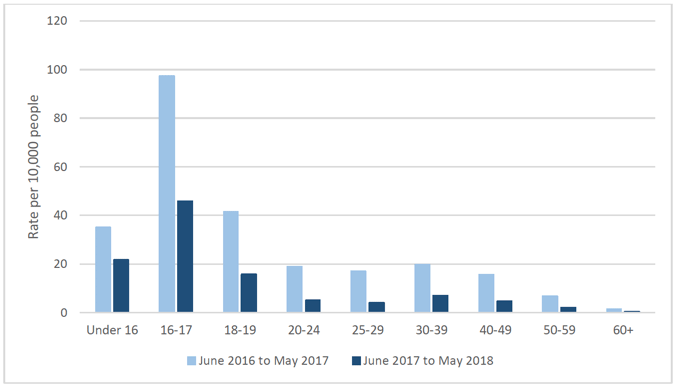
6.2.2 Sex
The number of searches and seizures amongst males in the population has always been significantly higher than that for females and this picture did not change markedly following the introduction of the CoP. In the twelve months before the CoP was introduced, males accounted for 89% of all searches and 82% of all seizures; whereas, after the introduction of the CoP the equivalent figures were 87% of all searches and 78% of all seizures. There was a greater proportionate decline in the number of both searches and seizures amongst males than females in the year after the introduction of the CoP. The rate of search per 10,000 men (aged 12 or over) in Scotland fell from 162 to 124, while the equivalent figures for women fell from 18 to 16. This represented a 24% fall in the rate of search for men but only 10% for women. Similarly, the rate of seizure per 10,000 men fell from 28 to 9 after the CoP was introduced, while it fell for women from 5 to 2 per 10,000 women. This represented a 66% decline in the seizure rate for men and a 56% reduction for women.
The age patterns of search and seizure rates for males and females were broadly similar to those observed in Figures 6.1 and 6.2. To identify where there were key differences, Figure 6.3 shows the percentage difference in search rate per capita for the twelve months before and after the introduction of the CoP, by sex and for different age groups. It is clear that the rate of search declined far more for men than for women across most age groups. The main differences were a greater decline in search rates amongst boys under the age of 16 compared to girls, and larger declines amongst men aged 30 or over compared to women. In some age groups, especially age 20-24 and age 30 or over, the rate of search for women declined very little. The largest fall in search rates for both men and women was in the 16-17 age category, and the level of decline within this age group was very similar.
The main factor explaining the lower level of decline amongst women was the inclusion on the NSSU database of searches conducted as part of a warrant (introduced by the 2016 Act). Including these searches in the overall numbers had the biggest impact on searches amongst women aged 30 or over, mainly because the number of searches amongst this group was already very small. Whereas, the introduction of searches under warrant for men did not have the same effect because the overall number of searches for men was so much larger.
Figure 6.3: Percentage difference in rate of statutory search by age and sex pre- and post-implementation of the CoP
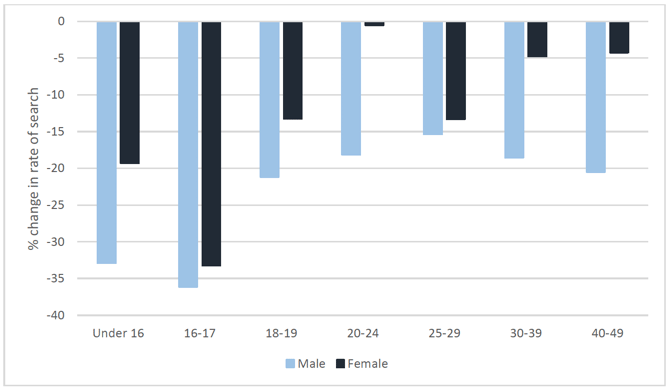
Note: Rates for age 50 and above are excluded due to small numbers.
The percentage difference in seizure rates before and after the introduction of the CoP is shown for males and females by age group in Figure 6.4. Again, caution should be taken in interpreting the figures as some of the numbers are very small (especially for women); however, this chart shows that the rate of seizure declined fairly consistently for both men and women across all age groups. There is some variation in terms of the extent of the difference by age but, overall, Figure 6.4 suggests that the reduction in seizures affected both sexes more or less equally.
Figure 6.4: Percentage difference in rate of seizures by age and sex pre- and post-implementation of the CoP
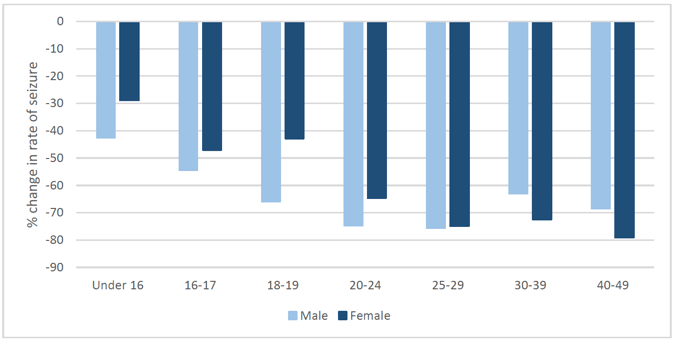
Note: Rates for age 50 and above are excluded due to small numbers.
6.2.3 Ethnicity
As noted in previous research (Murray 2014; McVie and Murray 2017), the vast majority of searches and seizures in Scotland involve people who self-define as belonging to a White ethnic group. The analysis conducted for this report confirmed that this continued to be the case, as shown in Table 6.1. In the year prior to the introduction of the CoP, 92% of all encounters involved people self-defining as White, of which the majority (84% overall) described themselves as White Scottish. There was a small reduction in this proportion in the twelve months after the introduction of the CoP, with 88% of all encounters involving White people (78% being White Scottish). The most common other self-defined White ethnicities in the year following the introduction of the CoP were White English (3%) and White British (4%). The non-White ethnic groups shown in Table 6.1 made up a small proportion of all encounters in both periods, and there was little change over time.
Table 6.1: Number of encounters by ethnic group, pre and post-implementation of the CoP
| Self-defined ethnic group | June 2016 to May 2017 | June 2017 to May 2018 | Difference in % share | ||
|---|---|---|---|---|---|
| N | % share | N | % share | ||
| White Scottish | 37,022 | 84% | 25,160 | 78% | -6% |
| White British | 1,060 | 2% | 1,168 | 4% | +2% |
| White English | 907 | 2% | 887 | 3% | +1% |
| White Polish | 544 | 1% | 474 | 2% | +1% |
| White Other | 927 | 2% | 732 | 2% | 0% |
| Asian (Pakistani/Bangladeshi /Chinese/Indian) | 1,032 | 2% | 641 | 2% | 0% |
| African/Caribbean/Black | 639 | 1% | 374 | 1% | 0% |
| Mixed or Other ethnic group | 1,065 | 2% | 398 | 1% | -1% |
| Ethnicity unknown | 1,053 | 2% | 2,473 | 8% | +6% |
Note: Column percentages may not total 100% due to rounding.
In the year following the introduction of the CoP there was a large increase in the proportion of encounters for whom the person's ethnic status was recorded as 'unknown' (from 2% of all searches and seizures prior to the CoP to 8% afterwards). This was also identified during the six month review (see McVie 2018) and discussions with Police Scotland at that time indicated that this was mainly due to a change in policing policy requiring police officers not to 'guess' the ethnicity of some individuals when the information had not been specifically requested. According to the NSSU, this was most commonly the case with individuals whom officers believed to be 'White Scottish'. There was no evidence that individuals had become more likely to refuse this information. It is notable that in the period since the publication of the six month review report, the proportion of encounters with an ethnicity defined as unknown has reduced considerably (from 7% in January 2018 to 3% in May 2018), suggesting that recording practice has been improved in light of the six month review.
When encounters in which the ethnicity of the individual is unknown are excluded from the analysis, the relative share of all searches and seizures across ethnic groups (as shown in Table 6.1) is broadly in line with the profile of the Scottish population as measured by the 2011 Census (National Records of Scotland 2013). Encounters involving people from a White ethnic group increased slightly from 94% in the year preceding the introduction of the CoP to 95% in the year after, which is broadly in line with the Census estimate of 96% of the Scottish population. The breakdown of non-White ethnic groups is also broadly in line with Census estimates. This is not suggestive of ethnic bias in the use of search and seizure at a national level (the numbers, especially for seizures, are too small to reliably report at sub-national level). However, this statement only holds true if the overall ethnic profile of the Scottish population has not changed over time (more up to date population estimates are not available) and if the profile of those encounters where ethnicity was unknown was broadly similar to those that were known (it is not possible to establish this).
Examining the total number of searches across ethnic groups is useful in terms of determining the overarching profile of encounters across the population, but rates per capita provide a better indication of whether there is disparity in the use of the tactic between ethnic groups. Rates per capita were calculated using population data from the 2011 Census; however, caution is required in calculating and interpreting population-based rates for ethnic groups for three key reasons (see McVie and Murray 2017, McVie 2018a and 2018b). Firstly, the absolute number of searches involving non-White people is far smaller than that for White people and so the degree of error around rates for non-White people is likely to be greater (which means they could appear to be over-inflated). Secondly, the 2011 Census is the only source of national population data for ethnicity but this is highly rounded and may be significantly out of date, which is also a potential source of error. And thirdly, the stop and search database does not identify whether individuals were subject to multiple searches and, therefore, rates may appear greater than they actually are. This is likely to be especially problematic if multiple searches are more common amongst non-White than White people, as suggested by other UK research evidence (for example, see Medina Ariza 2014).
Bearing in mind the caveats set out above, Figure 6.5 shows the rates of search and seizure per 10,000 people for those who self-defined as White or non-White only (as figures are not considered reliable for specific ethnic groups). Note that this chart can most reliably be used to show the change in search rates within ethnic groups across the two periods studied, but no reliable conclusions can be drawn about differences in rates between ethnic groups. The rates of seizure were far smaller than the rates of search, for both White and non-White people, although the data appears to show that seizures were greater amongst White people across both time periods. The rates of search for non-White people appeared to be almost twice that of those for White people in the period prior to the introduction of the CoP; however, the gap closed considerably in the twelve months after the CoP was introduced. The far larger proportionate decline in searches amongst non-White people could be due to a reduction in the total number of searches or a reduction in the number of multiple searches of specific individuals.
Figure 6.5: Difference in rate per capita of search and seizure pre- and post-implementation of the CoP, by ethnic group
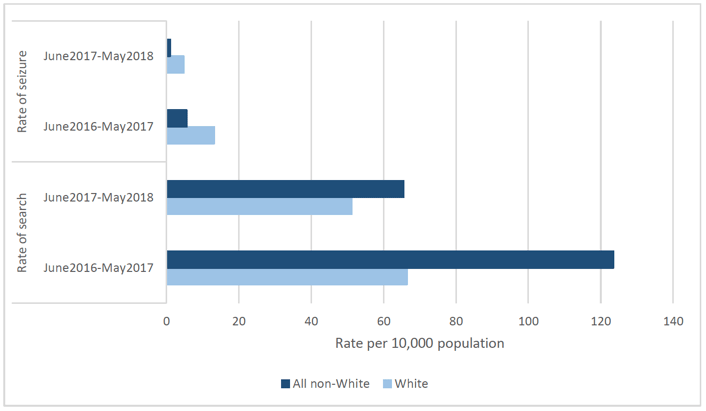
Rates per capita can be more reliably used to compare change within specific ethnic groups. Figure 6.6 shows the percentage change in the rate of search and seizure in the twelve months before and after the introduction of the CoP for the four main ethnic groups included in the Scottish Census (African has been grouped together with Caribbean and Black due to small numbers). It shows large percentage declines in seizure rates across all ethnic groups, but especially amongst the non-White groups. Note, however, that the total number of seizures amongst non-White groups was far smaller than for White people (i.e. less than 2% of all seizures in the year before the introduction of the CoP involved non-White people, and this fell to less than 1% in the year after).
There were also large percentage declines in search rates across all ethnic groups, but again especially amongst non-White groups. Figure 6.6 shows that rates of search amongst White people fell by 23%, whereas search rates fell by 36% amongst those self-defining as Asian and by 39% for those self-defining as Black, Caribbean or African. The largest proportionate decline in search rates was amongst Mixed or Other ethnic groups, which fell by 62%. Like seizures, the number of searches involving non-White people were far smaller than for White people (i.e. 7% of all searches in the year before the introduction of the CoP involved non-White people, falling to 5% in the year after).
Overall, these findings indicate a greater than expected reduction in both searches and seizures involving those from non-White backgrounds. This suggests that the changes implemented by Police Scotland in the year following the introduction of the CoP have had a greater positive impact on non-White people compared to White people. As noted above, this may be in terms of a reduction in the total number of searches or it could be due to a reduction in multiple searches of specific individuals. The numbers involved are very small, however, so it is worth reiterating that caution is needed in interpreting these figures.
Figure 6.6: Percentage change in rate of search and seizure pre- and post-implementation of the CoP, by ethnic group
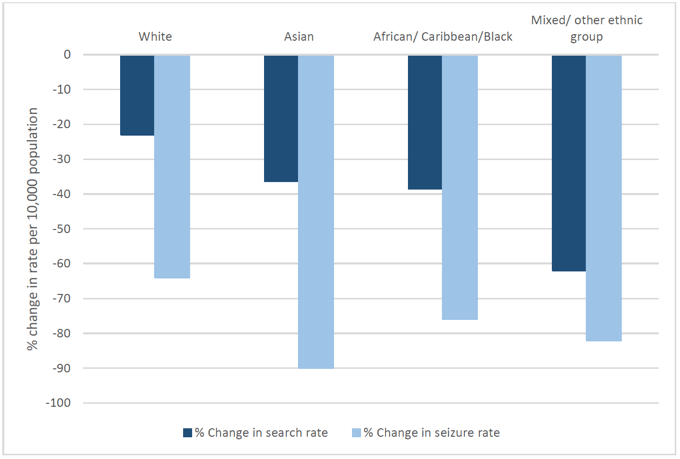
6.3 Change in positive detections by age, sex and ethnicity
The rates per capita, as set out in the previous section, provide valuable information about the extent to which search and seizure are used for different groups of the population. However, it is difficult to establish anything about disproportionality and fairness without having underlying information about the level of demand on policing caused by different groups. An equally important factor is to examine the extent to which searches result in a positive detection in order to identify whether certain groups are being searched on the basis of lower levels of suspicion compared to others. As noted in Section 2.2, the overall detection rate in the twelve month period after the CoP was introduced was 38%, an increase of 7% from the equivalent period of the previous year. This section of the report examines whether there was any significant change in the detection rate by age, sex and ethnicity following the introduction of the CoP
6.3.1 Age
The change in the detection rate by age group is presented in Figure 6.7, which shows a higher positive detection rate for all age groups following the introduction of the CoP. Overall, there was a 21% increase in detection rates; however, there was a greater proportionate increase for some age groups than others. The lowest percentage increase in detection rates was amongst those aged 18-19 (19%), 20-29 (16%) and 30-39 (14%), while the highest percentage increase was for those aged 16-17 (39%) and 50-59 (32%). There was also a slightly larger than average increase in positive searches amongst young people under the age of 16 of 23%.
Figure 6.7: Percentage of searches resulting in a positive outcome pre- and post-implementation of the CoP, by age group
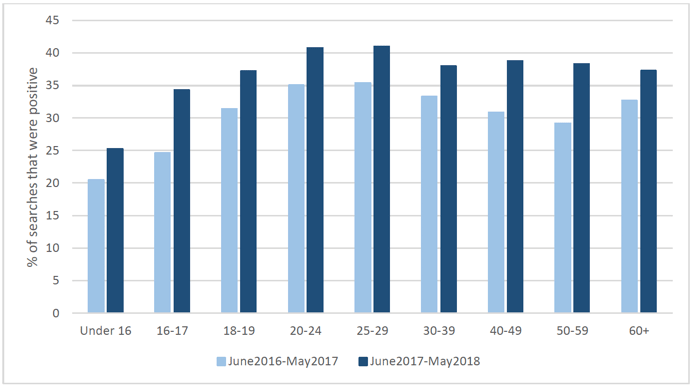
Figure 6.7 suggests that the overall reduction in number of searches since the introduction of the CoP has resulted in more positive outcomes across all age groups. Moreover, there has been a sizeable improvement in positive outcomes amongst those in the youngest age groups, especially in the 16-17 year old age group. For those aged 18 or over, there is far greater equality in the rate of positive search, which is above 35% for all ages. This suggests that the requirement for reasonable suspicion is being applied more stringently and evenly amongst adults. However, the positive search rate for those aged under 18 remains lowest overall, most especially for those aged under 16 which is still noticeably lower than for all other age groups (i.e. 13% below the average positive rate). This suggests that the threshold of suspicion used when searching children and young people continues to be lower than that applied to adults, so there is still room for improvement in increasing the positive search rate amongst this age group.
6.3.2 Sex
As noted in Section 6.2.2, there was a larger proportionate fall in the rate of search for men than for women in the year following the introduction of the CoP. Overall, searches involving women went from 11% of all encounters in the previous year to 13% in the year after the CoP was introduced. Figure 6.8 also shows that there was a bigger increase in the percentage of positive searches amongst men compared to women. The percentage of positive searches for men increased from 31% to 38%; while, the percentage for women increased from 31% to 36%. While this does not represent a very large difference between men and women in percentage terms, it is statistically significant. In other words, in the year following the introduction of the CoP searches involving men were significantly more likely to result in a positive detection than those involving women.
Looking at search results by reason, drug searches involving men were significantly more likely to be positive than those involving women during both time periods. Searches conducted under Warrant (which were predominantly for drugs) were also more likely to be positive for men than women. Whereas, searches for stolen property were significantly more likely to be positive for women than men. There was no sex difference in the outcome of weapon searches, which were least likely to be positive overall. The effect of sex on positive search rates will be discussed further in Section 7.3.
Figure 6.8: Percentage of searches resulting in a positive outcome pre- and post-implementation of the CoP, by sex
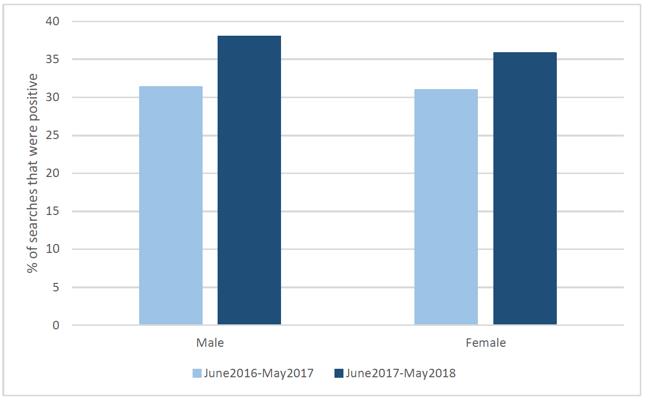
6.3.3 Ethnicity
The percentage of searches resulting in a positive outcome also increased across all ethnic groups, as illustrated in Figure 6.9. In the twelve months before the CoP was introduced, the positive detection rate was highest amongst those who self-defined as White (32%) and lowest for those self-defining as belonging to a Mixed or Other ethnic group (20%). In the year after the CoP was implemented, the positive detection rate continued to be highest for those who self-defined as White (39%); however, the gap in success rates between searches of those from a White ethnic group and those from people in any Other ethnic group was much reduced. For example, 35% of searches involving people who self-defined as belonging to any of the Asian or African/Caribbean/Black ethnic groups resulted in a positive detection, and the figure for those from Mixed/Other ethnic groups was slightly higher at 36%. Recall from Figure 6.6 that searches involving people from a Mixed/Other ethnic group saw the largest overall reduction across these two time periods, which suggests that police officers were using a far higher threshold of reasonable suspicion when searching people from these ethnic backgrounds after the CoP came into being (although bear in mind that numbers were small). There was a lower increase in detection rate amongst those for whom ethnicity was not known.
Figure 6.9: Percentage of searches resulting in a positive outcome pre- and post-implementation of the CoP, by ethnic group
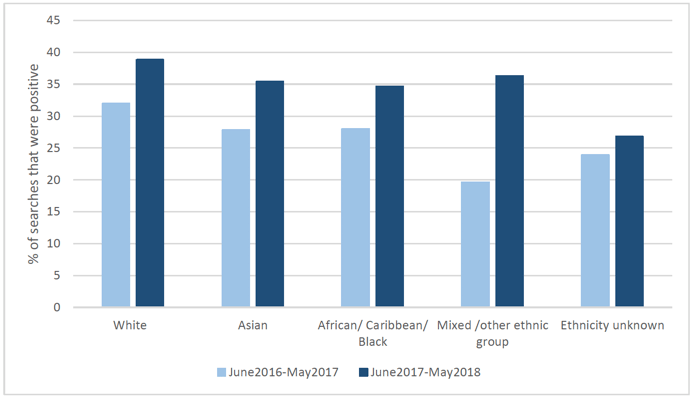
6.5 Summary of section 6
A series of research reports have highlighted that stop and search in Scotland was being used disproportionately amongst certain groups, especially children and young people. This review examined whether the introduction of the CoP had resulted in any change in terms of the use of search for those of certain ages or other groups with protected characteristics. Only three variables were available for analysis in the Stop and Search Database: age, sex and ethnicity.
The analysis found that levels of search had reduced across all ages and, while young people in their mid to late teens continued to be the most likely group to experience a search, the degree of disproportionality in terms of targeting these groups had significantly declined in the twelve months following the introduction of the CoP. Rates of seizure (mainly involving alcohol) had also declined significantly across all age groups; however, seizure rates had declined less for young people under the age of 18 than for older people. This is most likely due to continued concern within Police Scotland about the danger of alcohol-related harm amongst young people in Scotland.
The total number of searches and seizures had declined for both males and females in the twelve months following the introduction of the CoP, although proportionately more so for males than females. Search rates had declined across all age groups for males, and for some age groups for females. The difference appears to explained largely by the inclusion in the database, following the introduction of the CoP, of searches conducted under Warrant. This had a greater impact on the profile of female searches as it inflated already small numbers. Reductions in seizure rates were very similar for males and females across all age groups, suggesting that changes in practice affected both sexes more or less equally.
In terms of ethnicity, searches and seizures predominantly involved White people both before and after the introduction of the CoP, although the overall profile of searches more or less matched the population profile for Scotland. Non-recording of ethnic group during searches increased in the period following the introduction of the CoP. This was also identified in the six month review report, but there was evidence that Police Scotland had taken steps to rectify the situation. The rate per capita of searches had declined within all ethnic groups, and the reductions were greater for encounters involving people who self-defined as non-White than White. Overall search rates per capita appeared to be higher for non-White ethnic groups than for White people, although there are strong health warnings about drawing any conclusions from differences between ethnic groups due to the problems of using 2011 Census data to calculate comparable rates.
Differences in absolute levels of search are not necessarily problematic if the detection rates do not indicate biased decision making practices. In the twelve month review, there was a significant increase in the positive detection rates for all age groups after the introduction of the CoP, particularly for 16-17 year olds and those aged 50-59. Since the introduction of the CoP, there is far greater equity in the rate of positive search amongst those aged 18 or over; however, positive detection rates continue to be lowest for those aged under 18. This suggests that the threshold of reasonable suspicion is being applied more stringently and evenly amongst adults than young people, so there remains room for improvement in conducting searches amongst young people.
There was a significant increase in positive detection rates for both men and women; however, searches of males were more likely to result in a positive outcome than those involving females in the year following the introduction of the CoP (there was no sex difference in the previous year). This sex difference was mainly explained by searches for drugs (including under Warrant) which were significantly more likely to be positive for men. Detection rates also improved amongst all ethnic groups, especially those from Mixed or Other ethnic groups, although numbers in these groups were small.
Overall, these findings indicate that the reduction in the number of searches following the introduction of the CoP has coincided with an increase in positive outcomes, and this is true across all groups with protected characteristics. Nevertheless, there continue to be signs of inequality between some groups in terms of who is searched and how successful those searches are. It is impossible from the analysis conducted here to say whether there are good explanations for these inequalities.
Contact
Email: ryan.paterson@gov.scot
There is a problem
Thanks for your feedback